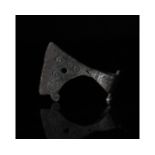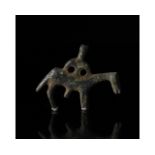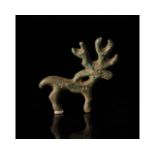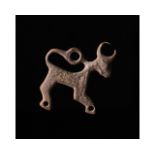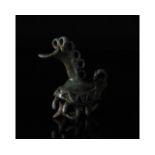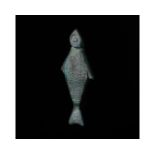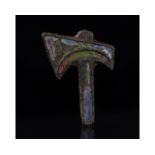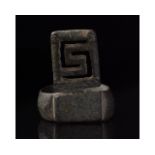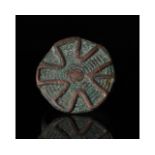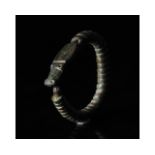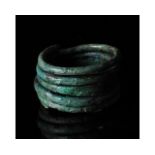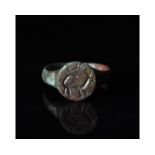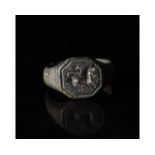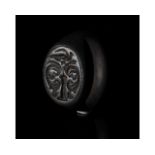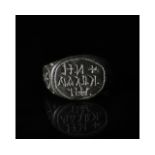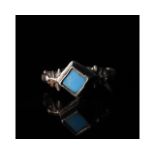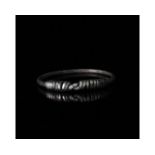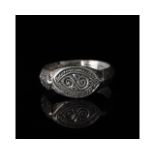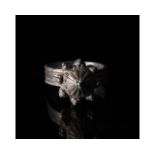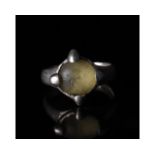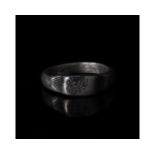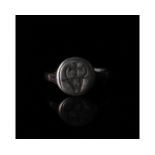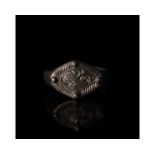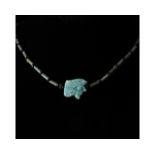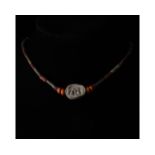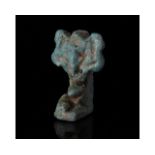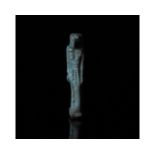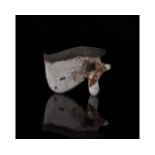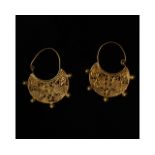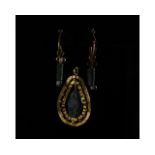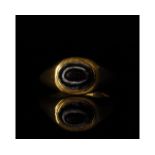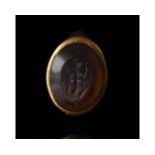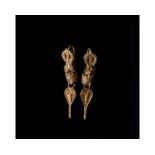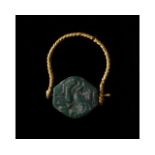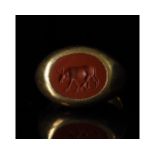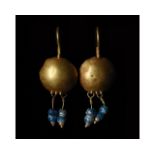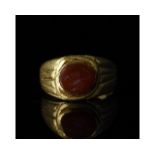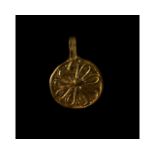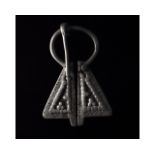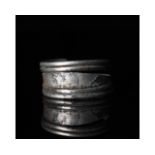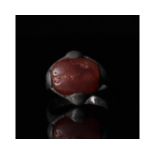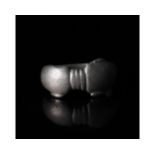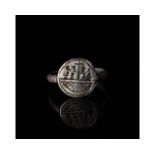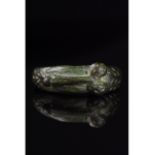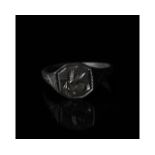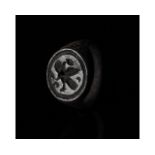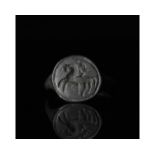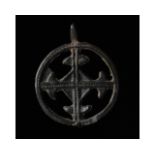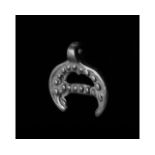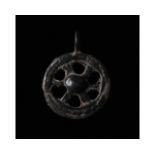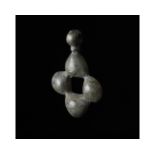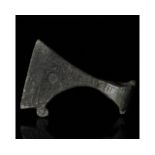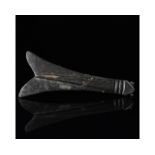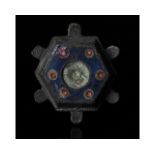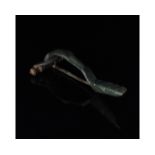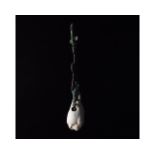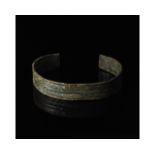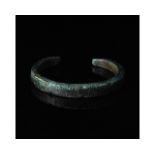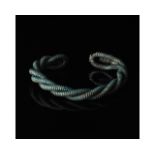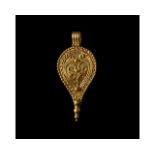Refine your search
Estimate
Category
- Jewellery (171)
- Arms, Armour & Militaria (168)
- Greek, Roman, Egyptian & Other Antiquities (36)
- Sculpture (21)
- Collectables (20)
- Coins (18)
- Salvage & Architectural Antiques (11)
- Islamic Works of Art (9)
- Metalware (6)
- Vintage Fashion (6)
- Musical Instruments & Memorabilia (5)
- Glassware (4)
- Ceramics (3)
- Clocks (3)
- Oil, Acrylic paintings & Mixed Media (3)
- Ethnographica & Tribal Art (2)
- Furniture (2)
- Silver & Silver-plated items (2)
- Taxidermy & Natural History (2)
- Textiles (2)
- Wines & Spirits (2)
- Books & Periodicals (1)
- Carpets & Rugs (1)
- Lighting (1)
- Models, Toys, Dolls & Games (1)
- Prints (1)
- Russian Works of Art (1)
- Scientific Instruments (1)
- Stamps (1)
Filtered by:
- Item Type
- List
- Grid
A subscription to the Price Guide is required to view results for auctions ten days or older. Click here for more information
700-1100 AD, Viking Age. A superb bronze example of an axe or Perun amulet of the bearded variety comprising a suspension loop and stylised blade ...
Ca.700-900 AD, Viking Age. Bronze pendant comprising stylised beast and rider viewed in profile, with two circular suspension holes below the ride...
Ca.1000 BC, Luristan. Attractive cast bronze figurine of a stag with loop. The body is long and narrow with lengthy legs and a short tail. The pow...
VIKING ERA BRONZE BEAST PENDANT
Ca.700-900 AD, Viking Age. Bronze pendant comprising bull with prominent curving horns and long, flowing tail. Holes for suspension are located on...
VIKING BRONZE SLEIPNIR PENDANT
c. 900-1100 AD. Viking Age. A beautiful bronze pendant comprising a highly stylised, curvilinear representation of Sleipnir. Sleipnir, the eight-...
C. 300 AD, Roman. Bronze zoomorphic brooch in the form of a fish with well-modelled scales and slender tail. Hinge, pin and catchplate are well pr...
C. 300 AD, Roman. Axe-shaped brooch with enamelled panels in blue and red. This brooch type is typical of central European productions under the R...
ROMAN BRONZE KEY RING
Ca 1-300 AD, Roman. A bronze ring with a thick circular hoop, flattened, rectangular bezel and perpendicular projecting key featuring an openwork ...
ANCIENT LURISTAN BRONZE RING
2000-1000 BC, Luristani. Bronze ring comprising a circular hoop with a flattened section bearing incised linear decoration and large applied circu...
RARE CELTIC IRON AGE SNAKE RING
200-100 BC, Celtic Iron Age. Beautiful example of Celtic Iron Age snake ring, comprising a twisted loop and stylised serpentine head/tail terminal...
VIKING ERA BRONZE COILED RING
700-1100 AD, Viking Age. A bronze coiled ring intended to evoke the form of a snake. In Norse mythology, Jormungand (pronounced “YOUR-mun-gand;” O...
700-1100 AD, Viking Age. Beautiful bronze ring comprised of a circular hoop, with an round bezel bearing incised decoration in the form of a beast...
ROMAN BRONZE RING WITH BEAST
1-300 AD, Roman. Bronze ring with circular hoop and octagonal bezel with incised decoration depicting a beast of unclear identification. Perhaps t...
1200-1600 AD. Medieval. Bronze ring with circular hoop, gently flaring shoulders and an oval bezel. The bezel bears incised decoration in the form...
1200-1400 AD, Late Byzantine. Bronze ring with circular hoop featuring incised star-in-circle decoration and oval bezel featuring a Greek inscript...
1300-1400 AD, Late Medieval. Silver ring with circular hoop and raised decoration on the shoulders. The lozenge-shaped bezel encloses a beautiful ...
VIKING PERIOD SILVER KNOT RING
C. 900 AD, Viking Age. A silver ring with a circular-shaped hoop and wrapped decoration with a central faux knot. This simple yet elegant ornament...
C. 900 AD, Viking Age. A silver ring with a D-shaped hoop, an elliptical bezel with incised linear and curvilinear decorations that extend down th...
MEDIEVAL SILVER "CROWNED" RING
900-1200 AD, Byzantine. Silver ring with circular hoop and crown-shaped bezel with intricate "crown-shaped" bezel adorned through granulation and ...
C. 900 AD, Viking Age. A silver ring with a circular-shaped hoop and a round bezel set with a light coloured gem secured by four additional 'arms....
1-300 AD, Roman. Silver ring with circular hoop, shoulders with incised chevron decoration and raised, rectangular bezel with abstract incised dec...
1000-1500 AD, Crusader Period. Silver ring comprising a circular hoop with flattened round bezel bearing incised decoration of a cross and bull's ...
C. 900 AD, Viking Age. A silver ring with a circular-shaped hoop and a lozenge-shaped bezel with incised decorations, the centremost of which is a...
712-30 BC, Late Period/Ptolemaic. A beautiful restrung necklace with tubular and discoid beads as well as blue faience Eye of Horus pendant, piece...
Ancient Egyptian. Striking restrung necklace comprising red, grey and brown hardstone beads of circular and annular form, arranged around a steati...
EGYPTIAN FAIENCE AMULET OF SHU
712-30 BC, Late Period/Ptolemaic. A very fine blue faience Shu amulet with raised detail. Pierced longitudinally for suspension. Egyptian culture ...
EGYPTIAN FAIENCE AMULET OF THOTH
712-30 BC, Late Period/Ptolemaic. A beautiful blue faience Thoth amulet showing the god with the head of an ibis striding forward and wearing a sh...
712-30 BC, Late Period/Ptolemaic. A beautiful faience Eye of Horus pendant with raised detail and pierced transversely for suspension. The Ancient...
400-600 AD, Early Byzantine. Open-work gold earrings in a crescent shape, decorated with extensive granulation and featuring a cross, four birds a...
C. 1-300 AD, Roman. Set of Roman pendant and earrings. The teardrop-shaped pendant comprises a dark green stone enclosed within two concentric gol...
C. 1-200 AD, Roman. Gold roman ring featuring bow-shaped hoop with prominent shoulders and protruding black and white "eye" bezel. Excellent condi...
C. 1-300 AD, Roman. Gold intaglio ring with D-shaped hoop, flattened oval bezel and elliptical, domed intaglio depicting standing Minerva. Minerva...
C. 1-200 AD, Roman. Pair of gold pendant earrings comprising inverted teardrops and flower motifs with filigree and granulated decoration. These b...
C. 700-500 BC, Phoenecian. Gold ring with corded, unclosed loop attaching to flat, hexagonal seal made of green stone. The seal is incised with a ...
1-300 AD, Roman. Gold ring with a D-shaped hoop formed from a thick, flat-sectioned, flaring band bearing a red carnelian intaglio with an incised...
C. 1-300 AD. Romano-Egyptian. A beautiful pair of gold earrings each comprising a large golden disk with decorative granulations from which hangs ...
1-300 AD, Roman. Gold ring with a circular hoop formed from a thick, flat-sectioned, flaring band with incised linear decorations bearing a red in...
ROMAN GOLD FLORAL PENDANT
C. 1-300 AD, Roman. A beautiful gold floral pendant comprising a circular disk and an suspension loop decorated with a nine petalled flower. This ...
Ca. 700- 1100 AD. Viking Era. A fine silver penannular brooch with flaring terminals decorated with raised dots arranged in geometric patterns and...
VIKING SILVER COILED RING
700-1100 AD, Viking Age. A heavy silver coiled ring, with wide central portion intended to evoke the form of a snake. In Norse mythology, Jormunga...
C. 900 AD, Viking Age. A silver ring with a circular-shaped hoop and a rectangular bezel set with a carnelian gem secured by four additional 'arms...
ROMAN SILVER TWO DOLPHINS RING
c. 1-300 AD. Roman. A heavy silver ring with a D-shaped hoop comprised of two stylised dolphins touching noses. This item probably adorned the han...
c. 1000-1500 AD. Medieval. A silver ring with a round hoop and a circular bezel bearing incised decoration in the form of a ship and sailors. This...
c. 1-300 AD. Roman. A beautiful bronze ring comprising a circular, flat-sectioned band with an applied phallus and incised decoration on the upper...
1100-1500 AD, Medieval. Fine bronze ring with circular hoop and octagonal bezel depicting an eagle in flight within a plain border. Heraldry, or t...
1100-1500 AD, Medieval. Heavy bronze ring with circular hoop and round bezel bearing a highly detailed depiction of an eagle in flight within a ro...
RARE NORMAN RING WITH HORSE
1000-1200 AD, Norman. Rare bronze ring with circular hoop and round bezel bearing incised decoration described within a circle. The decoration com...
c. 1000-1500 AD. Medieval. A open work cross pendant featuring a stylised geometric cross, a circular frame and a suspension loop. Crosses are the...
VIKING ERA LUNAR BRONZE PENDANT
Ca.900 AD, Viking Age. Bronze Viking open work Lunar pendant with loop, decorated with raised dots (granulations). Vikings were expert navigators,...
ROMAN BRONZE WHEEL AMULET
C. 1-300 AD, Roman. Bronze amulet in the form of a six-spoked wheel with supension loop. The wheel is a symbol of fate and fortune in the Roman wo...
RARE EARLY MEDIEVAL BRONZE CROSS
C. 600-900 AD, Early Medieval. A beautiful cast, open work cross pendant formed from four bulbous arms. Crosses are the principal symbol of the Ch...
700-1100 AD, Viking Age. A superb bronze example of an axe or Perun amulet of the bearded variety comprising a suspension loop and stylised blade ...
ROMAN BRONZE FLY / CICADA BROOCH
C. 100-200 AD, Roman. Bronze amulet in the form of a fly or cicada, with broad, curving wings and stylised head. The catch plate and hinge are sti...
c. 100-200 AD, Roman. Umbonate ('shield-like') hexagonal brooch with central rondel within a blue panel featuring red circular details and six per...
C. 300 AD, Roman. Superb bronze bow brooch with prominent coiled head terminating in finely-executed spheres and incised linear decoration intersp...
Ca. 700-1100 AD. Viking Era. A Viking era bronze penannular brooch with flaring terminals decorated with raised dots arranged in geometric pattern...
700-900 AD, Viking Age. A heavy bronze bracelet with incised decoration bands comprising curvilinear designs and pips. In Viking society, arm ring...
700-1100 AD, Viking Age. A heavy bronze bracelet with punched dot and box decoration, and raised ridges on the terminals thought to be a stylised ...
700-1100 AD, Viking Age. A heavy bronze twisted bracelet comprised strands of bronze woven together with incised lines intended to evoke the form ...
ROMAN GOLD FILIGREE PENDANT
c. 1-300 AD. Roman. A beautiful gold pendant with a suspension loop in the form of an inverted teardrop with applied curvilinear scrollwork and gr...

